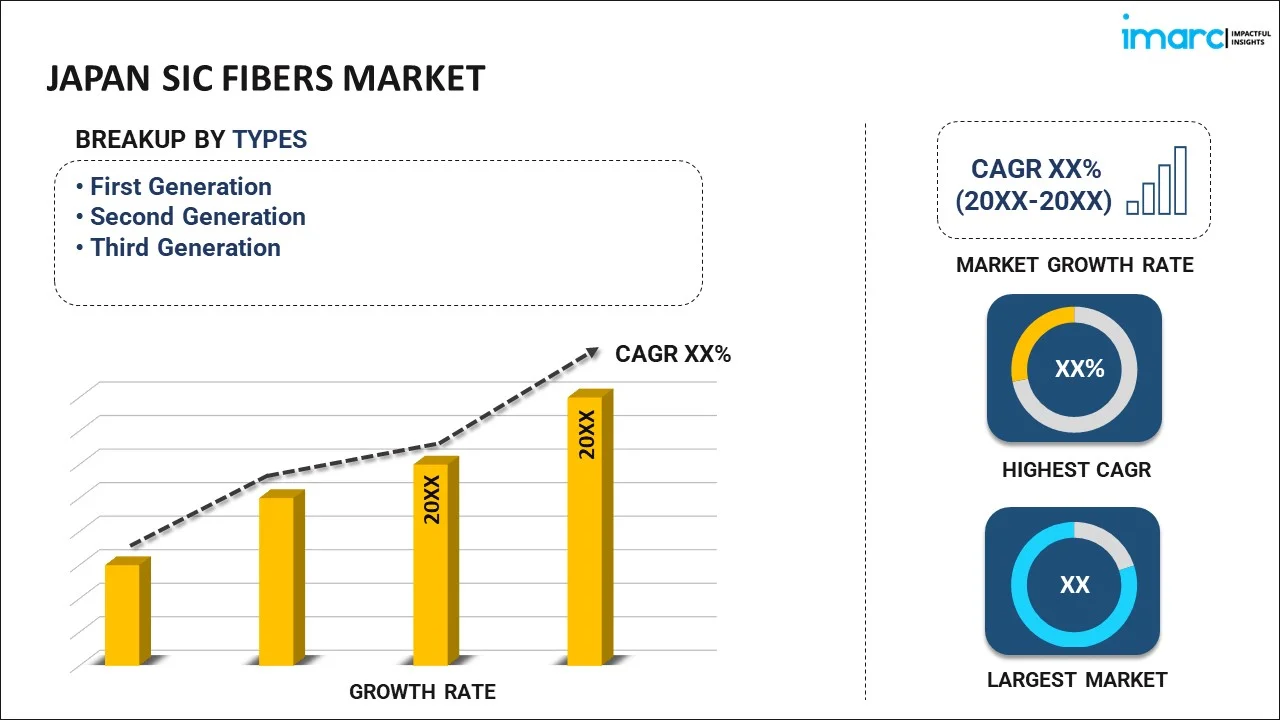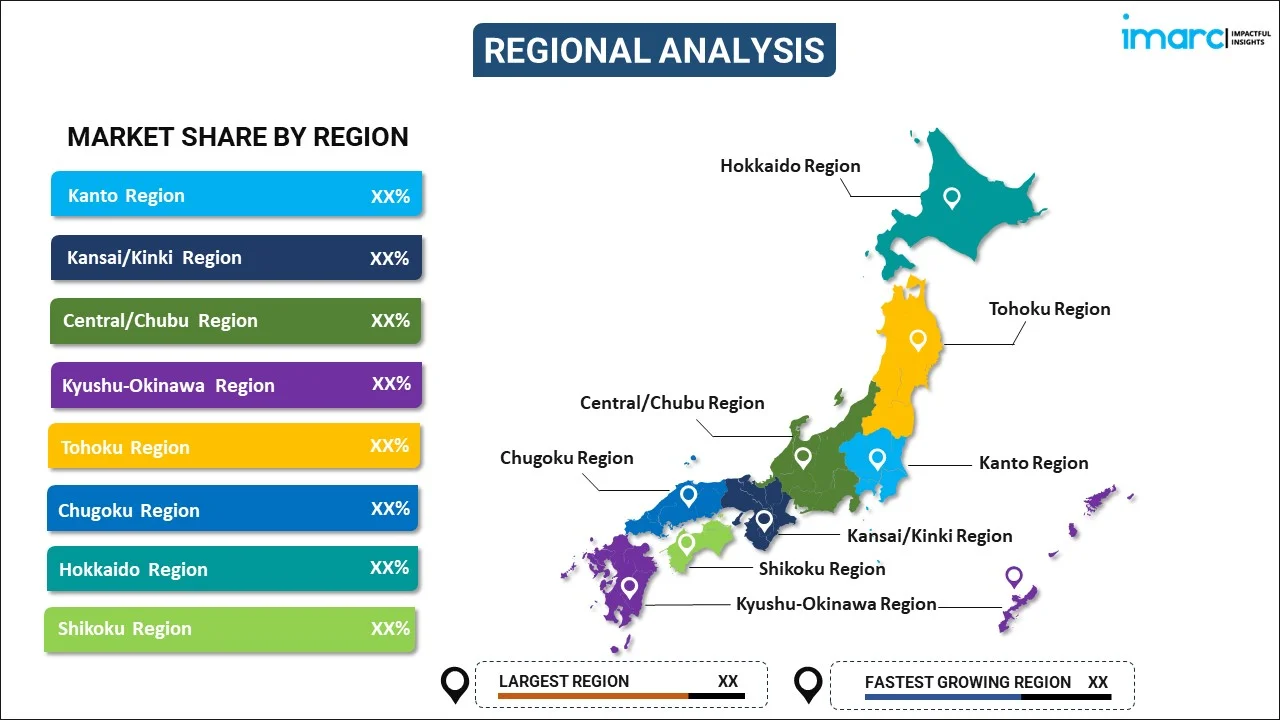
Japan SiC Fibers Market Report by Type (First Generation, Second Generation, Third Generation), Form (Continuous, Woven, and Others), Phase (Crystalline, Amorphous), Usage (Composites, Non-Composites), Application (Aerospace and Defense, Energy and Power, and Others), and Region 2025-2033
Market Overview:
Japan SiC fibers market size reached USD 40.6 Million in 2024. Looking forward, IMARC Group expects the market to reach USD 142.5 Million by 2033, exhibiting a growth rate (CAGR) of 15.0% during 2025-2033. Ongoing research and development activities to establish cost-effective manufacturing technologies, along with the growing demand for materials that offer durability and efficiency, enhanced resistance to high temperatures, and lightweight solutions, are primarily driving the market growth.
|
Report Attribute
|
Key Statistics
|
|---|---|
|
Base Year
|
2024 |
|
Forecast Years
|
2025-2033 |
|
Historical Years
|
2019-2024
|
| Market Size in 2024 | USD 40.6 Million |
| Market Forecast in 2033 | USD 142.5 Million |
| Market Growth Rate (2025-2033) | 15.0% |
Silicon carbide fibers, commonly referred to as sic fibers, are advanced inorganic fibers crafted for utilization in cutting-edge applications across industries like aerospace, nuclear, and power generation. Renowned for their exceptional strength, lightweight nature, and capacity to withstand extreme temperatures, these fibers are derived from silicon carbide, a robust covalent crystal material. These fibers find application in reinforcing materials operating in high-temperature environments where durability and thermal stability are of utmost importance. They are seamlessly integrated into a diverse array of composite materials, encompassing metal, ceramic, and carbon matrix composites, to substantially enhance their mechanical characteristics and resilience. These enhanced composites are subsequently employed in the fabrication of heat-resistant equipment, turbine engines, nuclear reactors, and a wide range of other components subjected to high stress conditions.
Japan SiC Fibers Market Trends:
The Japan SiC fibers market is experiencing significant growth, driven by its pivotal role in advanced industries within the country. Japan, renowned for its cutting-edge technological innovations, particularly in aerospace, nuclear, and power generation sectors, places a high demand on high-performance materials like silicon carbide fibers, which is positively influencing the regional market. In the aerospace sector, Japan's active involvement in space exploration and aircraft manufacturing necessitates materials that can withstand the rigors of space and high-speed flight. Besides this, SiC fibers are integral in reinforcing composites used in aircraft structures, ensuring both durability and lightweight design, thereby acting as another significant growth-inducing factor. Furthermore, Japan's commitment to nuclear energy demands materials with exceptional thermal stability and durability. Moreover, SiC fibers find extensive use in power generation, specifically in the production of high-efficiency gas turbines and heat-resistant equipment. The demand for efficient and reliable power generation solutions in Japan further propels the SiC fibers market. In essence, the Japan SiC fibers market is expected to thrive due to the country's technological leadership and its need for high-performance materials in critical industries. These fibers continue to be at the forefront of Japan's quest for innovation and excellence in advanced applications.
Japan SiC Fibers Market Segmentation:
IMARC Group provides an analysis of the key trends in each segment of the market, along with forecasts at the country level for 2025-2033. Our report has categorized the market based on type, form, phase, usage, and application.
Type Insights:

- First Generation
- Second Generation
- Third Generation
The report has provided a detailed breakup and analysis of the market based on the type. This includes first generation, second generation, and third generation.
Form Insights:
- Continuous
- Woven
- Others
A detailed breakup and analysis of the market based on the form have also been provided in the report. This includes continuous, woven, and others.
Phase Insights:
- Crystalline
- Amorphous
The report has provided a detailed breakup and analysis of the market based on the phase. This includes crystalline and amorphous.
Usage Insights:
- Composites
- Non-Composites
A detailed breakup and analysis of the market based on the usage have also been provided in the report. This includes composites and non-composites.
Application Insights:
- Aerospace and Defense
- Energy and Power
- Others
The report has provided a detailed breakup and analysis of the market based on the application. This includes aerospace and defense, energy and power, and others.
Regional Insights:

- Kanto Region
- Kansai/Kinki Region
- Central/ Chubu Region
- Kyushu-Okinawa Region
- Tohoku Region
- Chugoku Region
- Hokkaido Region
- Shikoku Region
The report has also provided a comprehensive analysis of all the major regional markets, which include Kanto Region, Kansai/Kinki Region, Central/ Chubu Region, Kyushu-Okinawa Region, Tohoku Region, Chugoku Region, Hokkaido Region, and Shikoku Region.
Competitive Landscape:
The market research report has also provided a comprehensive analysis of the competitive landscape. Competitive analysis such as market structure, key player positioning, top winning strategies, competitive dashboard, and company evaluation quadrant has been covered in the report. Also, detailed profiles of all major companies have been provided.
Japan SiC Fibers Market Report Coverage:
| Report Features | Details |
|---|---|
| Base Year of the Analysis | 2024 |
| Historical Period | 2019-2024 |
| Forecast Period | 2025-2033 |
| Units | Million USD |
| Scope of the Report | Exploration of Historical and Forecast Trends, Industry Catalysts and Challenges, Segment-Wise Historical and Predictive Market Assessment:
|
| Types Covered | First Generation, Second Generation, Third Generation |
| Forms Covered | Continuous, Woven, Others |
| Phases Covered | Crystalline, Amorphous |
| Usages Covered | Composites, Non-Composites |
| Applications Covered | Aerospace and Defense, Energy and Power, Others |
| Regions Covered | Kanto Region, Kansai/Kinki Region, Central/ Chubu Region, Kyushu-Okinawa Region, Tohoku Region, Chugoku Region, Hokkaido Region, Shikoku Region |
| Customization Scope | 10% Free Customization |
| Post-Sale Analyst Support | 10-12 Weeks |
| Delivery Format | PDF and Excel through Email (We can also provide the editable version of the report in PPT/Word format on special request) |
Key Questions Answered in This Report:
- How has the Japan SiC fibers market performed so far and how will it perform in the coming years?
- What has been the impact of COVID-19 on the Japan SiC fibers market?
- What is the breakup of the Japan SiC fibers market on the basis of type?
- What is the breakup of the Japan SiC fibers market on the basis of form?
- What is the breakup of the Japan SiC fibers market on the basis of phase?
- What is the breakup of the Japan SiC fibers market on the basis of usage?
- What is the breakup of the Japan SiC Fibers market on the basis of application?
- What are the various stages in the value chain of the Japan SiC fibers market?
- What are the key driving factors and challenges in the Japan SiC fibers?
- What is the structure of the Japan SiC fibers market and who are the key players?
- What is the degree of competition in the Japan SiC fibers market?
Key Benefits for Stakeholders:
- IMARC’s industry report offers a comprehensive quantitative analysis of various market segments, historical and current market trends, market forecasts, and dynamics of the Japan SiC fibers market from 2019-2033.
- The research report provides the latest information on the market drivers, challenges, and opportunities in the Japan SiC fibers market.
- Porter's five forces analysis assist stakeholders in assessing the impact of new entrants, competitive rivalry, supplier power, buyer power, and the threat of substitution. It helps stakeholders to analyze the level of competition within the Japan SiC fibers industry and its attractiveness.
- Competitive landscape allows stakeholders to understand their competitive environment and provides an insight into the current positions of key players in the market.
Need more help?
- Speak to our experienced analysts for insights on the current market scenarios.
- Include additional segments and countries to customize the report as per your requirement.
- Gain an unparalleled competitive advantage in your domain by understanding how to utilize the report and positively impacting your operations and revenue.
- For further assistance, please connect with our analysts.
 Inquire Before Buying
Inquire Before Buying
 Speak to an Analyst
Speak to an Analyst
 Request Brochure
Request Brochure
 Request Customization
Request Customization




.webp)




.webp)












